Understanding Change: Leadership, Impact, and Decision-Making
VerifiedAdded on 2024/06/11
|27
|5348
|280
Report
AI Summary
This report provides a detailed analysis of organizational change, focusing on its impact on strategy and operations within the context of Harrods Food Hall and Asda. It compares the organizational structures, operations, and strategies of these two companies, highlighting both similarities and differences. The report evaluates internal and external drivers of change, examining their effects on leadership, team, and individual behaviors. Furthermore, it assesses measures, such as Lewin's Change Management model, that can be taken to minimize the negative impacts of change on organizational behavior. The report also explores barriers to change and their influence on leadership decision-making, concluding with insights into effective change leadership strategies.

Understanding and Leading Change
1
1
Paraphrase This Document
Need a fresh take? Get an instant paraphrase of this document with our AI Paraphraser

Table of Contents
Introduction......................................................................................................................................3
Task 1: Managing the Impact of Change.........................................................................................4
Part A: Responding to Change....................................................................................................4
Part B: The Impact of Change.....................................................................................................7
Task 2: Leadership Decision Making............................................................................................15
Task 3: Leading Change................................................................................................................18
Conclusion.....................................................................................................................................23
Reference List................................................................................................................................24
2
Introduction......................................................................................................................................3
Task 1: Managing the Impact of Change.........................................................................................4
Part A: Responding to Change....................................................................................................4
Part B: The Impact of Change.....................................................................................................7
Task 2: Leadership Decision Making............................................................................................15
Task 3: Leading Change................................................................................................................18
Conclusion.....................................................................................................................................23
Reference List................................................................................................................................24
2

Introduction
Organizational change is a part of management theory, which deals with various stages that an
organization comes across as it makes progress. This change can be both for short and long term.
In other word, organizational change modification of organization’s process, structure and
practices. This change has an impact on every activity performed in the organization. This report
will cover the drivers of changes and how organizations will respond to such changes.
Leadership behaviours along with individual behaviours are affected through such changes. This
report will also focus on different barriers of change and their influence on leadership decision
making process. The chosen companies for this study are Harrods Food Hall and Asda.
3
Organizational change is a part of management theory, which deals with various stages that an
organization comes across as it makes progress. This change can be both for short and long term.
In other word, organizational change modification of organization’s process, structure and
practices. This change has an impact on every activity performed in the organization. This report
will cover the drivers of changes and how organizations will respond to such changes.
Leadership behaviours along with individual behaviours are affected through such changes. This
report will also focus on different barriers of change and their influence on leadership decision
making process. The chosen companies for this study are Harrods Food Hall and Asda.
3
⊘ This is a preview!⊘
Do you want full access?
Subscribe today to unlock all pages.

Trusted by 1+ million students worldwide

Task 1: Managing the Impact of Change
Part A: Responding to Change
P1: Compare different organisational examples where there has been an impact of change
on an organisation’s strategy and operations.
In order to elaborate the impact of change within organisational structure, strategy and operations
that are carried out within the firms, a comparative example of Asda and Harrods Foods Hall
has been demonstrated below.
Harrods Foods Hall, UK
Figure 1: Harrods Foods Hall
(Source: The MBS Group, 2018)
The Harrods Foods Hall is sumptuous departmental store that is located on Brompton Road in
Knightsbridge, London and is a brand of Harrods Group of Companies. The store occupies a 5-
acre site that consists of 330 departments, covering 1.1 million square feet. The company was
established by Charles Henry Harrod in the year 1824. In the year 2010, Harrods has taken
4
Part A: Responding to Change
P1: Compare different organisational examples where there has been an impact of change
on an organisation’s strategy and operations.
In order to elaborate the impact of change within organisational structure, strategy and operations
that are carried out within the firms, a comparative example of Asda and Harrods Foods Hall
has been demonstrated below.
Harrods Foods Hall, UK
Figure 1: Harrods Foods Hall
(Source: The MBS Group, 2018)
The Harrods Foods Hall is sumptuous departmental store that is located on Brompton Road in
Knightsbridge, London and is a brand of Harrods Group of Companies. The store occupies a 5-
acre site that consists of 330 departments, covering 1.1 million square feet. The company was
established by Charles Henry Harrod in the year 1824. In the year 2010, Harrods has taken
4
Paraphrase This Document
Need a fresh take? Get an instant paraphrase of this document with our AI Paraphraser

initiatives to expand their business in the international market of China and has opened a store in
Shanghai (harrods.com, 2018).
Asda, UK
Figure 2: Asda, UK
(Source: Prolific North, 2018)
Asda Stores Limited is a British supermarket retailer that has their whereabouts in Leeds, West
Yorkshire. The organisation was founded in the year 1965 through merging the supermarket
owned by the Asquith family with the Associated Dairies Company of Yorkshire. Asda
expanded its organisational structure and scope in the year 1970and 1980 into the South of
England by acquiring Allied Carpets, 61 large gateways supermarkets and other businesses such
as MFI (Asda.com, 2018).
Comparison between the organisational structure, operations and strategies of Asda and
Harrods Foods Hall
Similarities
5
Shanghai (harrods.com, 2018).
Asda, UK
Figure 2: Asda, UK
(Source: Prolific North, 2018)
Asda Stores Limited is a British supermarket retailer that has their whereabouts in Leeds, West
Yorkshire. The organisation was founded in the year 1965 through merging the supermarket
owned by the Asquith family with the Associated Dairies Company of Yorkshire. Asda
expanded its organisational structure and scope in the year 1970and 1980 into the South of
England by acquiring Allied Carpets, 61 large gateways supermarkets and other businesses such
as MFI (Asda.com, 2018).
Comparison between the organisational structure, operations and strategies of Asda and
Harrods Foods Hall
Similarities
5

Some of the basic similarities of organisational structures between Asda and Harrods Foods hall
are as follows:
Both of the organisations have better and well equipped self-checkout systems where the
customers easily withdraw their products after paying respective payments. With the help
of self-checkout systems, they ensure reliable and efficient delivery of products.
In the modern world, full of advanced technologies, both of the organisations has shifted
their promotional activities and have started to market their respective products and
services over their own online websites.
Both of the organisations have adopted the latest inventories equipments in order to
maintain sufficient industrialization within their operation departments, so that they are
able to modernise the manufacturing production procedures. They maintain improved
quality of operations within their organisational structure through Contingency Planning
(Yamakawa and Cardon, 2017).
Differences
The Harrods Foods hall has a different food product portfolio compared to that of Asda.
The product and service portfolio of Asda are grocery, general merchandise, and financial
service while Harrods Foods Hall handles the product and service of portfolio of luxury
food items, wine and hampers.
Within the organisational boundary of Harrods Foods Hall, the stores currently sustains
with 12,000 employees while that of Asda is equal to 165,000 according to the survey in
the year 2013.
Asda is merged with Walmart and Sainsbury’s pending while Harrods Foods Hall has its
alone establishment under the owner Qatar Holdings.
The Harrods Foods Hall has revenue worth equal to £769 million and its net income
according to survey in the year 2015 is equal to £126 million. Asda’s overall revenue is
equal to £21,666 million and net income of £791.7 million which is decreasing rapidly
according to the recent researches in the year 2016.
Since Asda has more numbers of stores compared to that of Harrods Foods Hall, they
have unique store formats such as Asda Supercentres, Asda Superstores, Asda
6
are as follows:
Both of the organisations have better and well equipped self-checkout systems where the
customers easily withdraw their products after paying respective payments. With the help
of self-checkout systems, they ensure reliable and efficient delivery of products.
In the modern world, full of advanced technologies, both of the organisations has shifted
their promotional activities and have started to market their respective products and
services over their own online websites.
Both of the organisations have adopted the latest inventories equipments in order to
maintain sufficient industrialization within their operation departments, so that they are
able to modernise the manufacturing production procedures. They maintain improved
quality of operations within their organisational structure through Contingency Planning
(Yamakawa and Cardon, 2017).
Differences
The Harrods Foods hall has a different food product portfolio compared to that of Asda.
The product and service portfolio of Asda are grocery, general merchandise, and financial
service while Harrods Foods Hall handles the product and service of portfolio of luxury
food items, wine and hampers.
Within the organisational boundary of Harrods Foods Hall, the stores currently sustains
with 12,000 employees while that of Asda is equal to 165,000 according to the survey in
the year 2013.
Asda is merged with Walmart and Sainsbury’s pending while Harrods Foods Hall has its
alone establishment under the owner Qatar Holdings.
The Harrods Foods Hall has revenue worth equal to £769 million and its net income
according to survey in the year 2015 is equal to £126 million. Asda’s overall revenue is
equal to £21,666 million and net income of £791.7 million which is decreasing rapidly
according to the recent researches in the year 2016.
Since Asda has more numbers of stores compared to that of Harrods Foods Hall, they
have unique store formats such as Asda Supercentres, Asda Superstores, Asda
6
⊘ This is a preview!⊘
Do you want full access?
Subscribe today to unlock all pages.

Trusted by 1+ million students worldwide
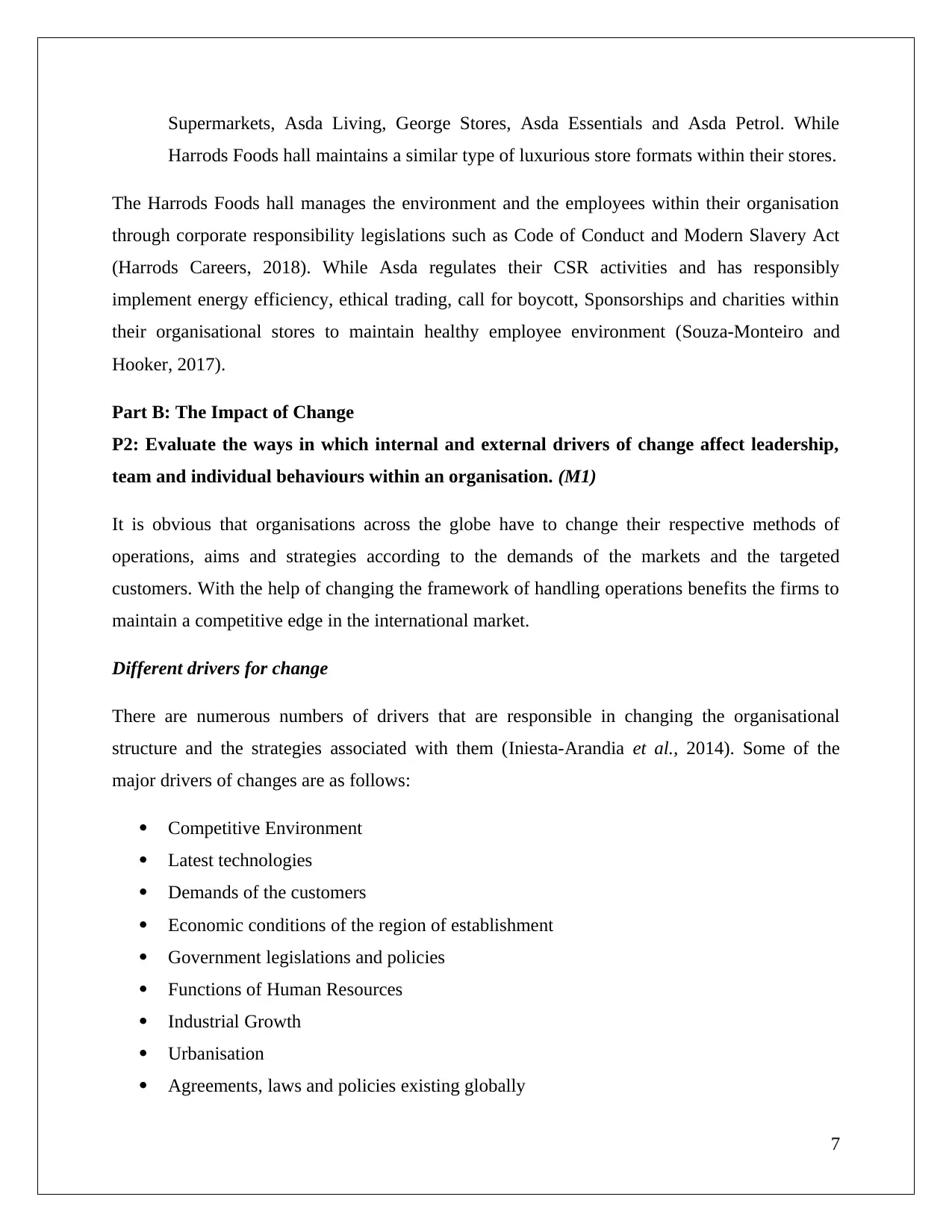
Supermarkets, Asda Living, George Stores, Asda Essentials and Asda Petrol. While
Harrods Foods hall maintains a similar type of luxurious store formats within their stores.
The Harrods Foods hall manages the environment and the employees within their organisation
through corporate responsibility legislations such as Code of Conduct and Modern Slavery Act
(Harrods Careers, 2018). While Asda regulates their CSR activities and has responsibly
implement energy efficiency, ethical trading, call for boycott, Sponsorships and charities within
their organisational stores to maintain healthy employee environment (Souza-Monteiro and
Hooker, 2017).
Part B: The Impact of Change
P2: Evaluate the ways in which internal and external drivers of change affect leadership,
team and individual behaviours within an organisation. (M1)
It is obvious that organisations across the globe have to change their respective methods of
operations, aims and strategies according to the demands of the markets and the targeted
customers. With the help of changing the framework of handling operations benefits the firms to
maintain a competitive edge in the international market.
Different drivers for change
There are numerous numbers of drivers that are responsible in changing the organisational
structure and the strategies associated with them (Iniesta-Arandia et al., 2014). Some of the
major drivers of changes are as follows:
Competitive Environment
Latest technologies
Demands of the customers
Economic conditions of the region of establishment
Government legislations and policies
Functions of Human Resources
Industrial Growth
Urbanisation
Agreements, laws and policies existing globally
7
Harrods Foods hall maintains a similar type of luxurious store formats within their stores.
The Harrods Foods hall manages the environment and the employees within their organisation
through corporate responsibility legislations such as Code of Conduct and Modern Slavery Act
(Harrods Careers, 2018). While Asda regulates their CSR activities and has responsibly
implement energy efficiency, ethical trading, call for boycott, Sponsorships and charities within
their organisational stores to maintain healthy employee environment (Souza-Monteiro and
Hooker, 2017).
Part B: The Impact of Change
P2: Evaluate the ways in which internal and external drivers of change affect leadership,
team and individual behaviours within an organisation. (M1)
It is obvious that organisations across the globe have to change their respective methods of
operations, aims and strategies according to the demands of the markets and the targeted
customers. With the help of changing the framework of handling operations benefits the firms to
maintain a competitive edge in the international market.
Different drivers for change
There are numerous numbers of drivers that are responsible in changing the organisational
structure and the strategies associated with them (Iniesta-Arandia et al., 2014). Some of the
major drivers of changes are as follows:
Competitive Environment
Latest technologies
Demands of the customers
Economic conditions of the region of establishment
Government legislations and policies
Functions of Human Resources
Industrial Growth
Urbanisation
Agreements, laws and policies existing globally
7
Paraphrase This Document
Need a fresh take? Get an instant paraphrase of this document with our AI Paraphraser
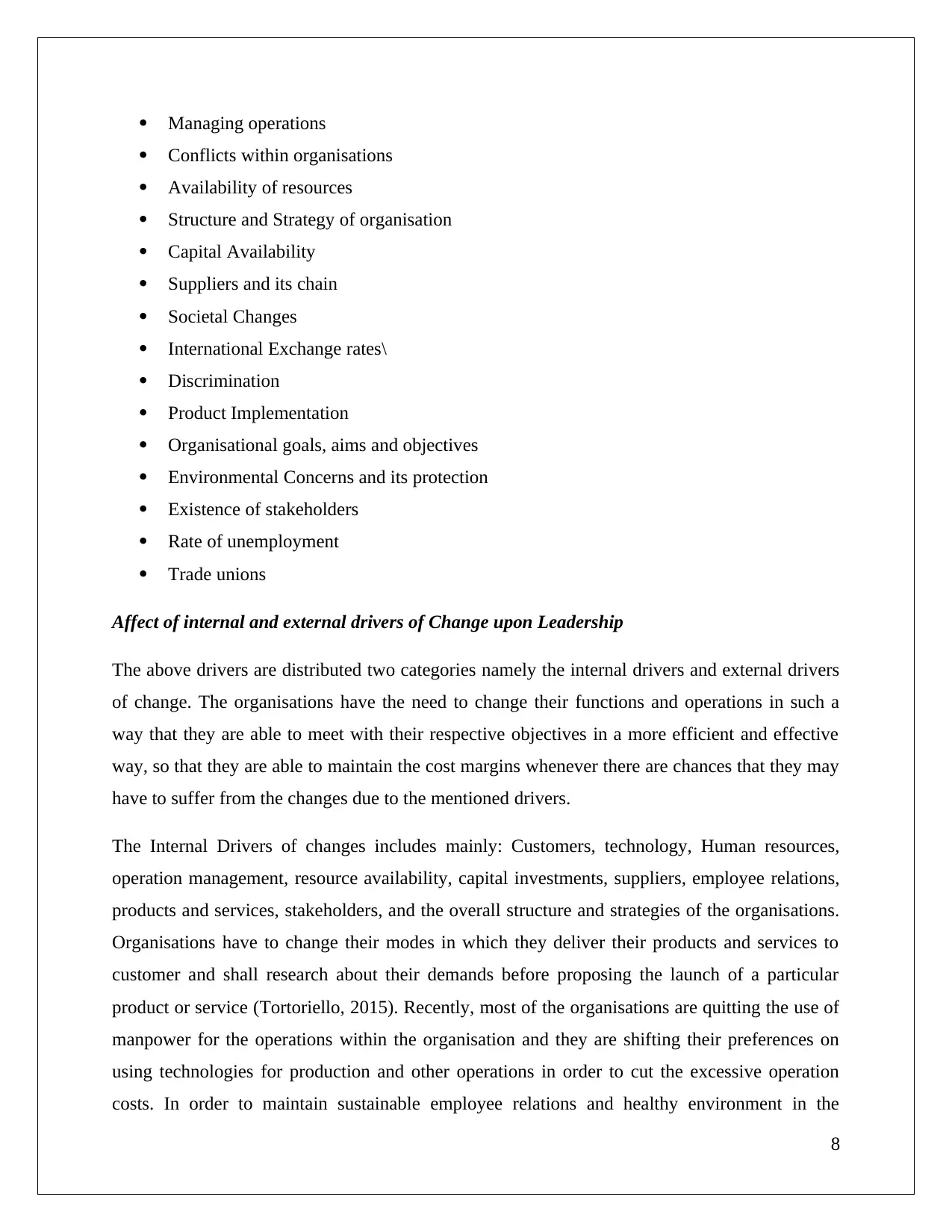
Managing operations
Conflicts within organisations
Availability of resources
Structure and Strategy of organisation
Capital Availability
Suppliers and its chain
Societal Changes
International Exchange rates\
Discrimination
Product Implementation
Organisational goals, aims and objectives
Environmental Concerns and its protection
Existence of stakeholders
Rate of unemployment
Trade unions
Affect of internal and external drivers of Change upon Leadership
The above drivers are distributed two categories namely the internal drivers and external drivers
of change. The organisations have the need to change their functions and operations in such a
way that they are able to meet with their respective objectives in a more efficient and effective
way, so that they are able to maintain the cost margins whenever there are chances that they may
have to suffer from the changes due to the mentioned drivers.
The Internal Drivers of changes includes mainly: Customers, technology, Human resources,
operation management, resource availability, capital investments, suppliers, employee relations,
products and services, stakeholders, and the overall structure and strategies of the organisations.
Organisations have to change their modes in which they deliver their products and services to
customer and shall research about their demands before proposing the launch of a particular
product or service (Tortoriello, 2015). Recently, most of the organisations are quitting the use of
manpower for the operations within the organisation and they are shifting their preferences on
using technologies for production and other operations in order to cut the excessive operation
costs. In order to maintain sustainable employee relations and healthy environment in the
8
Conflicts within organisations
Availability of resources
Structure and Strategy of organisation
Capital Availability
Suppliers and its chain
Societal Changes
International Exchange rates\
Discrimination
Product Implementation
Organisational goals, aims and objectives
Environmental Concerns and its protection
Existence of stakeholders
Rate of unemployment
Trade unions
Affect of internal and external drivers of Change upon Leadership
The above drivers are distributed two categories namely the internal drivers and external drivers
of change. The organisations have the need to change their functions and operations in such a
way that they are able to meet with their respective objectives in a more efficient and effective
way, so that they are able to maintain the cost margins whenever there are chances that they may
have to suffer from the changes due to the mentioned drivers.
The Internal Drivers of changes includes mainly: Customers, technology, Human resources,
operation management, resource availability, capital investments, suppliers, employee relations,
products and services, stakeholders, and the overall structure and strategies of the organisations.
Organisations have to change their modes in which they deliver their products and services to
customer and shall research about their demands before proposing the launch of a particular
product or service (Tortoriello, 2015). Recently, most of the organisations are quitting the use of
manpower for the operations within the organisation and they are shifting their preferences on
using technologies for production and other operations in order to cut the excessive operation
costs. In order to maintain sustainable employee relations and healthy environment in the
8
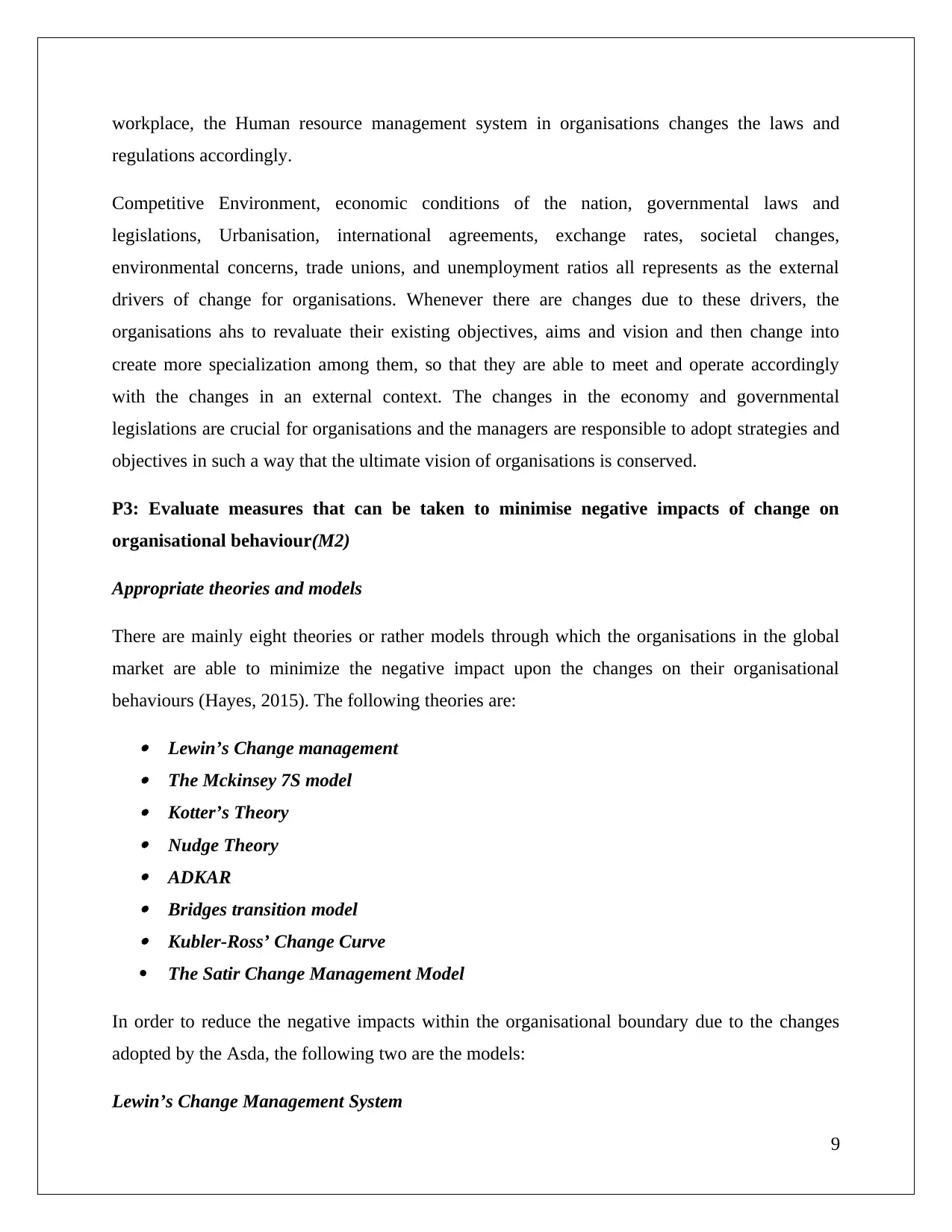
workplace, the Human resource management system in organisations changes the laws and
regulations accordingly.
Competitive Environment, economic conditions of the nation, governmental laws and
legislations, Urbanisation, international agreements, exchange rates, societal changes,
environmental concerns, trade unions, and unemployment ratios all represents as the external
drivers of change for organisations. Whenever there are changes due to these drivers, the
organisations ahs to revaluate their existing objectives, aims and vision and then change into
create more specialization among them, so that they are able to meet and operate accordingly
with the changes in an external context. The changes in the economy and governmental
legislations are crucial for organisations and the managers are responsible to adopt strategies and
objectives in such a way that the ultimate vision of organisations is conserved.
P3: Evaluate measures that can be taken to minimise negative impacts of change on
organisational behaviour(M2)
Appropriate theories and models
There are mainly eight theories or rather models through which the organisations in the global
market are able to minimize the negative impact upon the changes on their organisational
behaviours (Hayes, 2015). The following theories are:
Lewin’s Change management The Mckinsey 7S model Kotter’s Theory Nudge Theory ADKAR Bridges transition model Kubler-Ross’ Change Curve
The Satir Change Management Model
In order to reduce the negative impacts within the organisational boundary due to the changes
adopted by the Asda, the following two are the models:
Lewin’s Change Management System
9
regulations accordingly.
Competitive Environment, economic conditions of the nation, governmental laws and
legislations, Urbanisation, international agreements, exchange rates, societal changes,
environmental concerns, trade unions, and unemployment ratios all represents as the external
drivers of change for organisations. Whenever there are changes due to these drivers, the
organisations ahs to revaluate their existing objectives, aims and vision and then change into
create more specialization among them, so that they are able to meet and operate accordingly
with the changes in an external context. The changes in the economy and governmental
legislations are crucial for organisations and the managers are responsible to adopt strategies and
objectives in such a way that the ultimate vision of organisations is conserved.
P3: Evaluate measures that can be taken to minimise negative impacts of change on
organisational behaviour(M2)
Appropriate theories and models
There are mainly eight theories or rather models through which the organisations in the global
market are able to minimize the negative impact upon the changes on their organisational
behaviours (Hayes, 2015). The following theories are:
Lewin’s Change management The Mckinsey 7S model Kotter’s Theory Nudge Theory ADKAR Bridges transition model Kubler-Ross’ Change Curve
The Satir Change Management Model
In order to reduce the negative impacts within the organisational boundary due to the changes
adopted by the Asda, the following two are the models:
Lewin’s Change Management System
9
⊘ This is a preview!⊘
Do you want full access?
Subscribe today to unlock all pages.

Trusted by 1+ million students worldwide
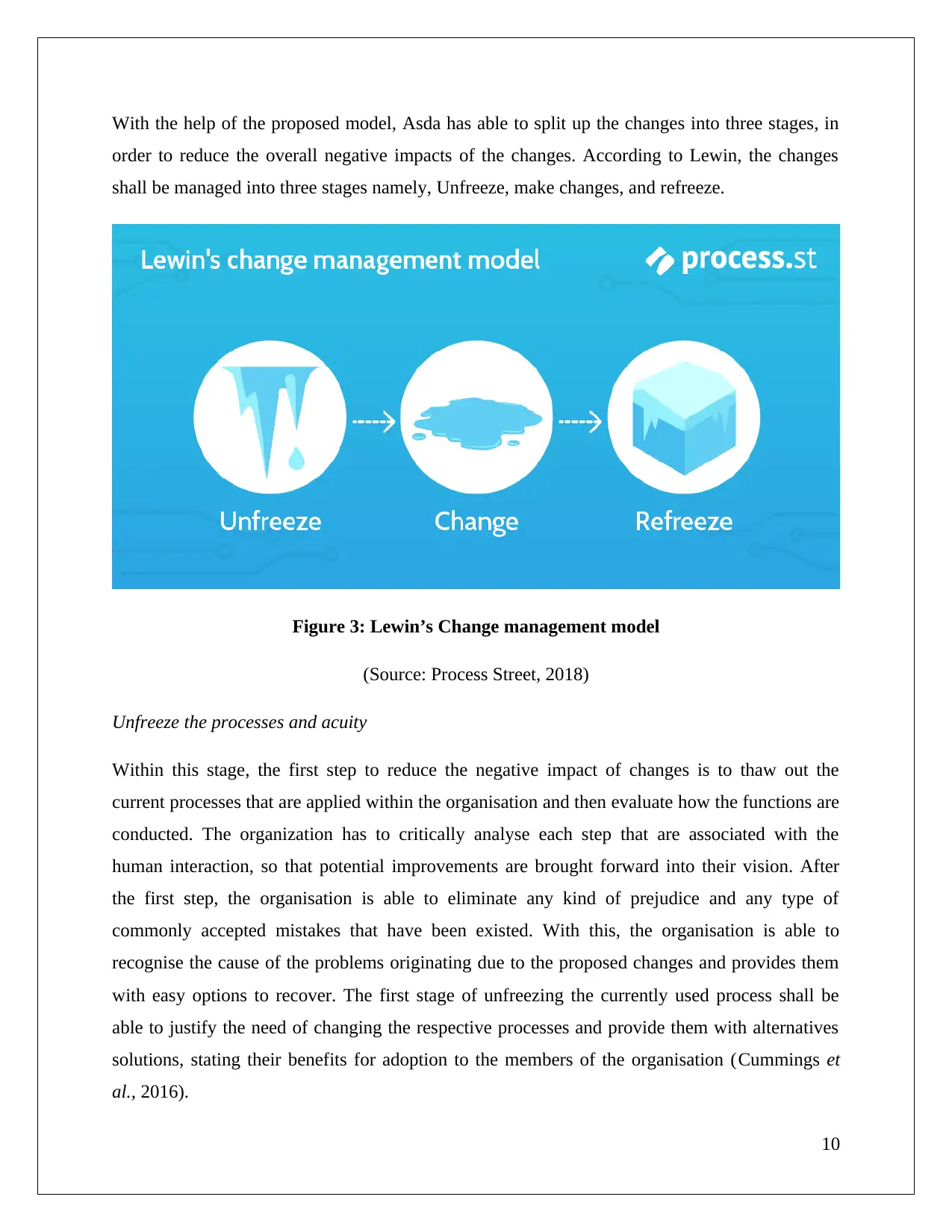
With the help of the proposed model, Asda has able to split up the changes into three stages, in
order to reduce the overall negative impacts of the changes. According to Lewin, the changes
shall be managed into three stages namely, Unfreeze, make changes, and refreeze.
Figure 3: Lewin’s Change management model
(Source: Process Street, 2018)
Unfreeze the processes and acuity
Within this stage, the first step to reduce the negative impact of changes is to thaw out the
current processes that are applied within the organisation and then evaluate how the functions are
conducted. The organization has to critically analyse each step that are associated with the
human interaction, so that potential improvements are brought forward into their vision. After
the first step, the organisation is able to eliminate any kind of prejudice and any type of
commonly accepted mistakes that have been existed. With this, the organisation is able to
recognise the cause of the problems originating due to the proposed changes and provides them
with easy options to recover. The first stage of unfreezing the currently used process shall be
able to justify the need of changing the respective processes and provide them with alternatives
solutions, stating their benefits for adoption to the members of the organisation (Cummings et
al., 2016).
10
order to reduce the overall negative impacts of the changes. According to Lewin, the changes
shall be managed into three stages namely, Unfreeze, make changes, and refreeze.
Figure 3: Lewin’s Change management model
(Source: Process Street, 2018)
Unfreeze the processes and acuity
Within this stage, the first step to reduce the negative impact of changes is to thaw out the
current processes that are applied within the organisation and then evaluate how the functions are
conducted. The organization has to critically analyse each step that are associated with the
human interaction, so that potential improvements are brought forward into their vision. After
the first step, the organisation is able to eliminate any kind of prejudice and any type of
commonly accepted mistakes that have been existed. With this, the organisation is able to
recognise the cause of the problems originating due to the proposed changes and provides them
with easy options to recover. The first stage of unfreezing the currently used process shall be
able to justify the need of changing the respective processes and provide them with alternatives
solutions, stating their benefits for adoption to the members of the organisation (Cummings et
al., 2016).
10
Paraphrase This Document
Need a fresh take? Get an instant paraphrase of this document with our AI Paraphraser

Making Changes
After proposing the causes of the problems associated with the adoption of change, the
organisation has to install the alternative options that have been proposed in the earlier stage. The
stage can be worth full if efficient and effective communication, change and guidance to the
teams associated with the scenario is adopted. According to Lewin, “Learning is more effective
when it is an active rather than a passive process”. The change has to be adopted in a such way
that if there are introduction of any kind of technology for the proposed change, the members
within the team has to perfectly educated with the specification of the technology, so that there
are no further opportunities of origination of problems.
Refreeze new state of affairs
After the changes have been installed, measured and tweak within the operations according to
the feedbacks generated during the proposal of change, the organisation has the need to refreeze
the new status quo. It is necessary since all the essential steps that have been taken in order to
reduce the negative impacts due to the changes will be worthless if the new state of affairs is not
permanently applied.
The model certainly has merits to be applied in order to overcome the negative impac6ts of
changes but the model also has some demerits. The merits and demerits are mentioned below:
Merits
Fantastic when the organisational business needs to drastically change, so that they are
able to succeed.
Helps in bringing forward the hidden mistakes.
Helpful for the organisation during the business process reengineering implementation.
Demerits
Certainly, the model is time consuming
Needs great deal of care
There are risks of alternating employees since their roles have been changed with the
adoption of different workflow.
11
After proposing the causes of the problems associated with the adoption of change, the
organisation has to install the alternative options that have been proposed in the earlier stage. The
stage can be worth full if efficient and effective communication, change and guidance to the
teams associated with the scenario is adopted. According to Lewin, “Learning is more effective
when it is an active rather than a passive process”. The change has to be adopted in a such way
that if there are introduction of any kind of technology for the proposed change, the members
within the team has to perfectly educated with the specification of the technology, so that there
are no further opportunities of origination of problems.
Refreeze new state of affairs
After the changes have been installed, measured and tweak within the operations according to
the feedbacks generated during the proposal of change, the organisation has the need to refreeze
the new status quo. It is necessary since all the essential steps that have been taken in order to
reduce the negative impacts due to the changes will be worthless if the new state of affairs is not
permanently applied.
The model certainly has merits to be applied in order to overcome the negative impac6ts of
changes but the model also has some demerits. The merits and demerits are mentioned below:
Merits
Fantastic when the organisational business needs to drastically change, so that they are
able to succeed.
Helps in bringing forward the hidden mistakes.
Helpful for the organisation during the business process reengineering implementation.
Demerits
Certainly, the model is time consuming
Needs great deal of care
There are risks of alternating employees since their roles have been changed with the
adoption of different workflow.
11
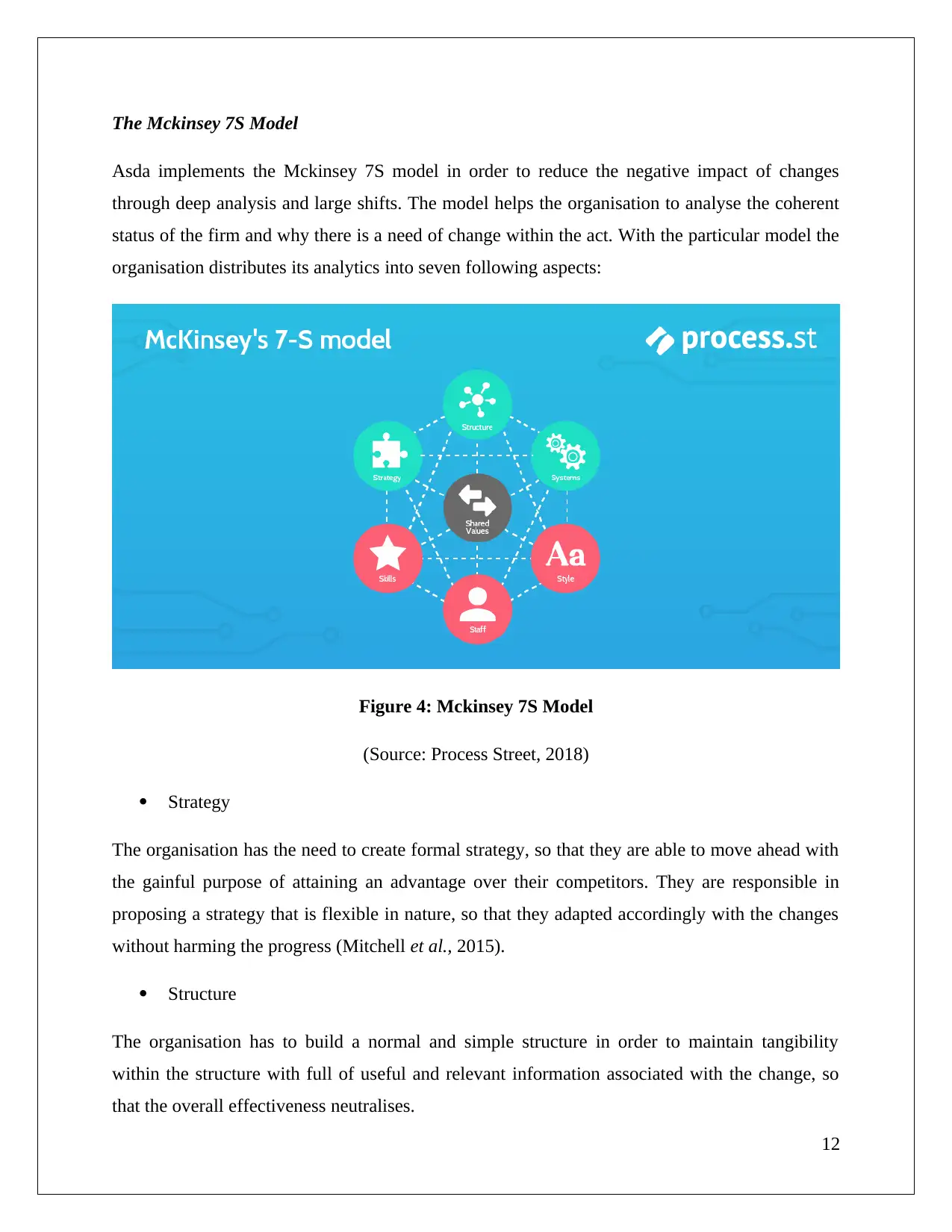
The Mckinsey 7S Model
Asda implements the Mckinsey 7S model in order to reduce the negative impact of changes
through deep analysis and large shifts. The model helps the organisation to analyse the coherent
status of the firm and why there is a need of change within the act. With the particular model the
organisation distributes its analytics into seven following aspects:
Figure 4: Mckinsey 7S Model
(Source: Process Street, 2018)
Strategy
The organisation has the need to create formal strategy, so that they are able to move ahead with
the gainful purpose of attaining an advantage over their competitors. They are responsible in
proposing a strategy that is flexible in nature, so that they adapted accordingly with the changes
without harming the progress (Mitchell et al., 2015).
Structure
The organisation has to build a normal and simple structure in order to maintain tangibility
within the structure with full of useful and relevant information associated with the change, so
that the overall effectiveness neutralises.
12
Asda implements the Mckinsey 7S model in order to reduce the negative impact of changes
through deep analysis and large shifts. The model helps the organisation to analyse the coherent
status of the firm and why there is a need of change within the act. With the particular model the
organisation distributes its analytics into seven following aspects:
Figure 4: Mckinsey 7S Model
(Source: Process Street, 2018)
Strategy
The organisation has the need to create formal strategy, so that they are able to move ahead with
the gainful purpose of attaining an advantage over their competitors. They are responsible in
proposing a strategy that is flexible in nature, so that they adapted accordingly with the changes
without harming the progress (Mitchell et al., 2015).
Structure
The organisation has to build a normal and simple structure in order to maintain tangibility
within the structure with full of useful and relevant information associated with the change, so
that the overall effectiveness neutralises.
12
⊘ This is a preview!⊘
Do you want full access?
Subscribe today to unlock all pages.

Trusted by 1+ million students worldwide
1 out of 27
Related Documents
Your All-in-One AI-Powered Toolkit for Academic Success.
+13062052269
info@desklib.com
Available 24*7 on WhatsApp / Email
![[object Object]](/_next/static/media/star-bottom.7253800d.svg)
Unlock your academic potential
Copyright © 2020–2025 A2Z Services. All Rights Reserved. Developed and managed by ZUCOL.




